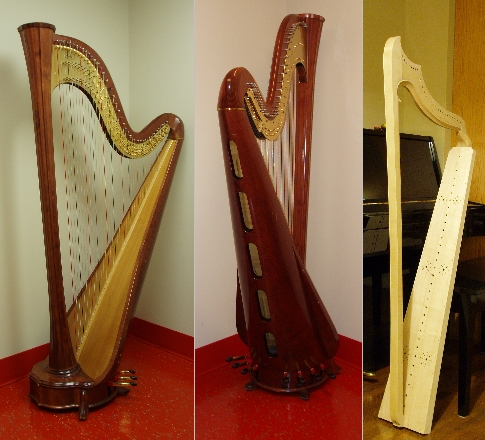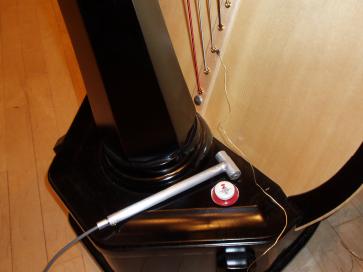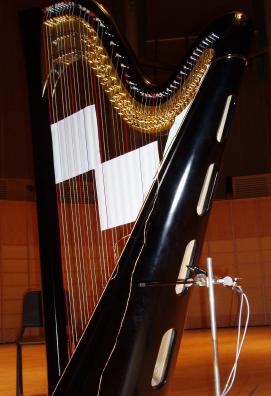Chris Waltham - cew@phas.ubc.ca
Shira Daltrop, Andrzej Kotlicki
Department of Physics and Astronomy, University of British Columbia
Vancouver BC V6T 1Z1
Popular version of paper 1pMU1
Presented Monday afternoon, May 18, 2009
157th ASA Meeting, Portland, OR
The most noticeable features of a harp are the graceful swan neck and the rank of strings. However, these strings would make little sound without the often unnoticed soundbox to which they are connected. Modern harp soundboxes consist of a thin soundboard made of an acoustic wood and a heavy conical back in which there are several holes. These holes exist to allow access to the string attachments but also have important acoustical properties. Harps more than 200 years old frequently have small holes in the soundboard itself, and none in the back.
 |
| Figure 1. Side and back views of a Salvi Aurora 47-string concert harp (courtesy of the University of British Columbia School of Music); replica of a late 17th century Gothic harp being built (not yet strung) by one of the authors (CEW). The five soundholes on the Aurora can be seen in the back of the soundbox; those in the Gothic are the six rosettes carved in the (front) soundboard. |
The unique layout of the harp means that the soundboard is excited at different points along its length, depending on which string is plucked. Most other string instruments have the string exciting the soundboard through the medium of a bridge positioned at one location on the sounboard. The sound produced by a harp is therefore determined not only by the frequencies of the string and their relationship to the resonant frequencies of the soundboard, but also by how the string is positioned with respect to the spatial patterns of the soundboard resonances.
  |
| Figure 2. Left: Impact hammer and accelerometer (small dot at base of string with thin gold cable attached). Right: microphone probe in one of the soundholes of an Aoyama Amphion 47M (Chan Centre for the Performing Arts, University of British Columbia). |
Using an impact hammer, a tiny accelerometer, and an microphone probe, we have been able to map the motion of a harp soundboard, and that of the air in the soundholes, in response to a force applied by a vibrating string. We show that the quality of the sound from a harp is determined, at least in part, by the relationship between the string frequencies and how the soundboard and soundholes respond at those frequencies. Unfortunate coincidences between resonances can cause some strings to boom and adjacent ones to be dead. Part of the skill of the harpmaker is to smooth out these peaks and valleys of sound production while maintaining the overall quality and quantity of sound from each string. Our analysis points out potential difficulties with a harp soundbox and indicates possible solutions. Although harpists have very different ways of talking about their instruments than do physicists, their assessment of individual instruments does seem to agree with our measurements.
  |
| Figure 3. Analysis of soundboard and soundhole velocities allow us to show the motion of air around the harp soundbox; this diagram shows the air motion and soundboard deflection at two adjacent resonant frequencies of the soundbox. In the case on the left, most sound production will be from the top of the harp, as the air at the front and back move in and out together, while that at the bottom has one side moving in while the other moves out. In the case on the right, the situation is reversed, and most sound will come from the bottom of the harp. |
References
J-L. Le Carrou, F. Gautier and E. Foltte, Experimental studies of the A0 and T1 modes of the concert harp, J. Acoust. Soc. Am. 121 (2007) 559-567.
C. Waltham and A. Kotlicki, Vibrational Characteristics of Harp Soundboards, J. Acoust. Soc. Am. 124 (2008) 1774-1780
S. Daltrop, Vibro-acoustic Behaviour of Harp Soundboxes, Honours Thesis, University of British Columbia, (2009).